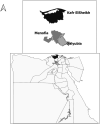Seroprevalence and associated risk factors for bovine leptospirosis in Egypt
- PMID: 38409338
- PMCID: PMC10897380
- DOI: 10.1038/s41598-024-54882-4
Seroprevalence and associated risk factors for bovine leptospirosis in Egypt
Abstract
Leptospirosis is caused by pathogenic bacteria of the genus Leptospira and is one of causative agents of reproductive problems leading to negative economic impact on bovine worldwide. The goal of this study was to investigate the seroprevalence of Leptospira spp. in cattle in some governorates of Egypt's Nile Delta and assess the risk factors for infection. A total of 410 serum samples were collected from cattle and examined using microscopic agglutination test. The overall seroprevalence was 10.2% and the most prevalent serovars were Icterohaemorrhagiae, Pomona and Canicola. In addition, the potential risk factors were associated Leptospira spp. infection were age, herd size, history of abortion, presence of dogs and rodent control. Thus, leptospirosis is common in dairy cattle in the Nile Delta and the presence of rodents in feed and dog-accessible pastures increases the risk of Leptospira spp. infection among animals.
Keywords: Cattle; Egypt; Leptospira spp; Risk factors; Serology.
© 2024. The Author(s).
Conflict of interest statement
The authors declare no competing interests.
Figures
Similar articles
-
Determination of the seroprevalence of Leptospira spp. and the main serovars circulating in cattle in the province of Manabí, Ecuador.Rev Sci Tech. 2019 Dec;38(3):787-800. doi: 10.20506/rst.38.3.3026. Rev Sci Tech. 2019. PMID: 32286567 English, Spanish.
-
Seroprevalence and herd-level risk factors for seroprevalence of Leptospira spp. in sheep, beef cattle and deer in New Zealand.N Z Vet J. 2018 Nov;66(6):302-311. doi: 10.1080/00480169.2018.1507770. Epub 2018 Sep 16. N Z Vet J. 2018. PMID: 30122123
-
Bovine leptospirosis: Prevalence, associated risk factors for infection and their cause-effect relation.Microb Pathog. 2017 Jun;107:149-154. doi: 10.1016/j.micpath.2017.03.032. Epub 2017 Mar 27. Microb Pathog. 2017. PMID: 28351712
-
Bovine leptospirosis: effects on reproduction and an approach to research in Colombia.Trop Anim Health Prod. 2022 Aug 9;54(5):251. doi: 10.1007/s11250-022-03235-2. Trop Anim Health Prod. 2022. PMID: 35943610 Free PMC article. Review.
-
Systematic review and meta-analysis on seroprevalence of leptospirosis in non-human primates worldwide.Res Vet Sci. 2024 Oct;178:105342. doi: 10.1016/j.rvsc.2024.105342. Epub 2024 Jul 2. Res Vet Sci. 2024. PMID: 39146598
Cited by
-
Seroprevalence and risk factors associated with Leptospira Hardjo among commercial dairy cattle farms of Rupandehi district, Nepal.BMC Vet Res. 2025 Jul 5;21(1):442. doi: 10.1186/s12917-025-04882-x. BMC Vet Res. 2025. PMID: 40618117 Free PMC article.
References
MeSH terms
Substances
LinkOut - more resources
Full Text Sources
Miscellaneous


